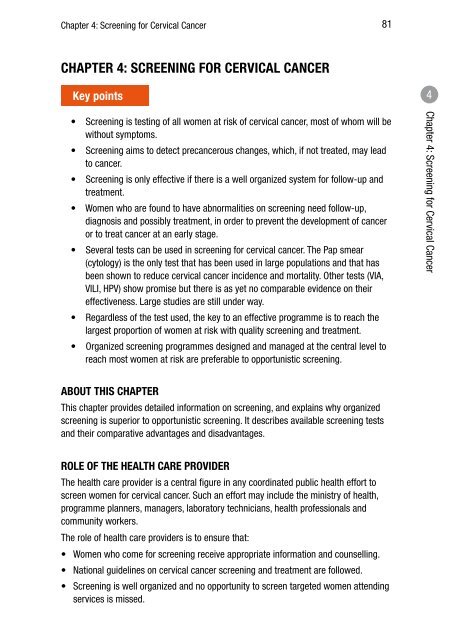CHAPTER 4: SCREENING FOR CERVICAL CANCER
CHAPTER 4: SCREENING FOR CERVICAL CANCER
CHAPTER 4: SCREENING FOR CERVICAL CANCER
You also want an ePaper? Increase the reach of your titles
YUMPU automatically turns print PDFs into web optimized ePapers that Google loves.
Chapter 4: Screening for Cervical Cancer 81<strong>CHAPTER</strong> 4: <strong>SCREENING</strong> <strong>FOR</strong> <strong>CERVICAL</strong> <strong>CANCER</strong>Key points4• Screening is testing of all women at risk of cervical cancer, most of whom will bewithout symptoms.• Screening aims to detect precancerous changes, which, if not treated, may leadto cancer.• Screening is only effective if there is a well organized system for follow-up andtreatment.• Women who are found to have abnormalities on screening need follow-up,diagnosis and possibly treatment, in order to prevent the development of canceror to treat cancer at an early stage.• Several tests can be used in screening for cervical cancer. The Pap smear(cytology) is the only test that has been used in large populations and that hasbeen shown to reduce cervical cancer incidence and mortality. Other tests (VIA,VILI, HPV) show promise but there is as yet no comparable evidence on theireffectiveness. Large studies are still under way.• Regardless of the test used, the key to an effective programme is to reach thelargest proportion of women at risk with quality screening and treatment.• Organized screening programmes designed and managed at the central level toreach most women at risk are preferable to opportunistic screening.Chapter 4: Screening for Cervical CancerABOUT THIS <strong>CHAPTER</strong>This chapter provides detailed information on screening, and explains why organizedscreening is superior to opportunistic screening. It describes available screening testsand their comparative advantages and disadvantages.ROLE OF THE HEALTH CARE PROVIDERThe health care provider is a central figure in any coordinated public health effort toscreen women for cervical cancer. Such an effort may include the ministry of health,programme planners, managers, laboratory technicians, health professionals andcommunity workers.The role of health care providers is to ensure that:• Women who come for screening receive appropriate information and counselling.• National guidelines on cervical cancer screening and treatment are followed.• Screening is well organized and no opportunity to screen targeted women attendingservices is missed.
















